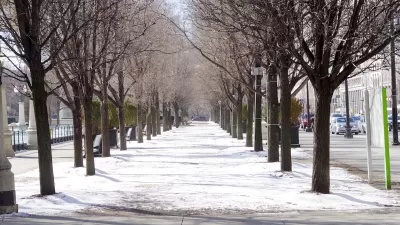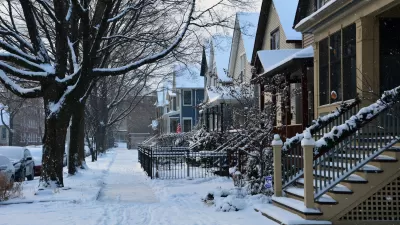Keeping sidewalks free of snow has historically been the task of adjacent property owners, forcing pedestrians and people with mobility challenges to navigate a patchwork of conditions. A new ordinance would place the responsibility on the city.

The responsibility for keeping Chicago sidewalks clear of snow and ice could shift from property owners to the city, if an ordinance proposed by Alderman Gilbert Villegas is successful in the city council. Kayleigh Padar describes the ordinance’s path to council in Block Club Chicago.
The ordinance is supported by more than 20 advocacy organizations including the AARP and disability rights groups. “Snow can make sidewalks dangerous for people with vision impairments who rely on walking sticks, for people who use wheelchairs or other mobility aides, for travelers with luggage and for parents wrestling strollers around snow, advocates said.”
Despite hefty fines for not clearing sidewalks, Ald. Villegas said that many sidewalks remain covered in snow, impeding mobility for the city’s pedestrians, particularly people with disabilities. Prior programs designed to help keep sidewalks clear failed, in part due to a lack of volunteers and resources. “The ordinance would prioritize providing services in systemically divested areas, particularly those with high population density and lots of vacant properties. Areas with lots of young families, older people and disabled people will also be prioritized during the pilot program, officials said.” Advocates say it’s important to view sidewalks as an integral part of a city’s transportation infrastructure, like roads, and ensure safe access to them year-round.
FULL STORY: Proposed ‘Plow The Sidewalks’ Ordinance Would Task City With Clearing Snowy And Icy Sidewalks

Study: Maui’s Plan to Convert Vacation Rentals to Long-Term Housing Could Cause Nearly $1 Billion Economic Loss
The plan would reduce visitor accommodation by 25,% resulting in 1,900 jobs lost.

North Texas Transit Leaders Tout Benefits of TOD for Growing Region
At a summit focused on transit-oriented development, policymakers discussed how North Texas’ expanded light rail system can serve as a tool for economic growth.

Why Should We Subsidize Public Transportation?
Many public transit agencies face financial stress due to rising costs, declining fare revenue, and declining subsidies. Transit advocates must provide a strong business case for increasing public transit funding.

How to Make US Trains Faster
Changes to boarding platforms and a switch to electric trains could improve U.S. passenger rail service without the added cost of high-speed rail.

Columbia’s Revitalized ‘Loop’ Is a Hub for Local Entrepreneurs
A focus on small businesses is helping a commercial corridor in Columbia, Missouri thrive.

Invasive Insect Threatens Minnesota’s Ash Forests
The Emerald Ash Borer is a rapidly spreading invasive pest threatening Minnesota’s ash trees, and homeowners are encouraged to plant diverse replacement species, avoid moving ash firewood, and monitor for signs of infestation.
Urban Design for Planners 1: Software Tools
This six-course series explores essential urban design concepts using open source software and equips planners with the tools they need to participate fully in the urban design process.
Planning for Universal Design
Learn the tools for implementing Universal Design in planning regulations.
City of Santa Clarita
Ascent Environmental
Institute for Housing and Urban Development Studies (IHS)
City of Grandview
Harvard GSD Executive Education
Toledo-Lucas County Plan Commissions
Salt Lake City
NYU Wagner Graduate School of Public Service





























